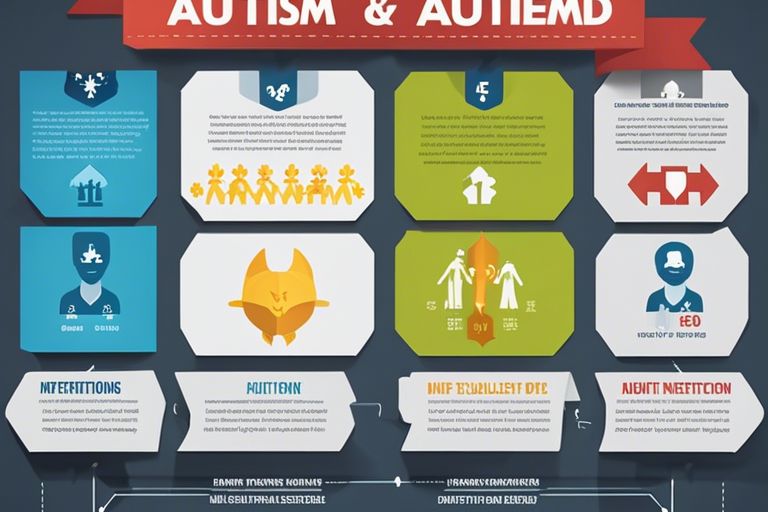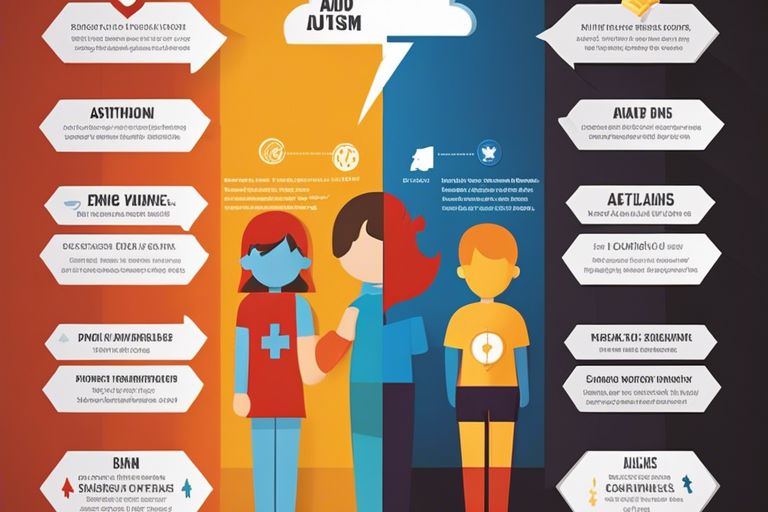Autism and ADHD are two neurodevelopmental disorders that can often be confused due to some overlapping symptoms. However, it is crucial to understand the differences between the two in order to provide appropriate support and interventions. Autism is characterised by challenges in social communication and interaction, as well as repetitive behaviours and restricted interests. On the other hand, ADHD is primarily associated with difficulties in attention, hyperactivity, and impulsivity. Despite their differences, both conditions can present similarities in terms of behavioural challenges, sensory sensitivities, and difficulties in executive functioning. By gaining a better understanding of the unique characteristics of autism and ADHD, we can ensure individuals receive the specific support they require to thrive.
Key Takeaways:
- Autism and ADHD are distinct conditions: While they share some similarities, such as difficulties with social interactions and sensory sensitivities, autism and ADHD are separate conditions with unique characteristics and diagnostic criteria.
- Differences in attention and focus: ADHD is primarily characterised by difficulties with attention, impulsivity, and hyperactivity, whereas individuals with autism may struggle more with social communication and repetitive behaviours.
- Individualised support is key: Understanding the specific needs and challenges of each individual is crucial for providing effective support and interventions for those with autism or ADHD. Tailoring strategies to suit each person’s unique profile can lead to better outcomes and quality of life.
Diagnostic Criteria
When differentiating between Autism and ADHD, it is essential to understand the specific diagnostic criteria used by healthcare professionals. By delving into the distinct characteristics required for the diagnosis of each condition, we can gain a deeper insight into the complexities of neurodevelopmental disorders.
Criteria for Autism Diagnosis
For a diagnosis of Autism Spectrum Disorder (ASD) to be made, individuals must display persistent deficits in social communication and interaction across multiple contexts. Additionally, restrictive and repetitive patterns of behaviour, interests, or activities must be present. To learn more about the detailed criteria for Autism diagnosis, click here.
Criteria for ADHD Diagnosis
The diagnostic criteria for Attention-Deficit/Hyperactivity Disorder (ADHD) involve a persistent pattern of inattention and/or hyperactivity-impulsivity that significantly impacts daily functioning or development. Symptoms must be present before the age of 12 and observed in two or more settings. To explore the specific criteria for ADHD diagnosis further, refer to this resource.
It is crucial to highlight that while both Autism and ADHD have their distinct diagnostic criteria, they can often present with overlapping symptoms, leading to misdiagnosis or dual diagnosis. Seeking evaluation and guidance from experienced healthcare professionals is essential to ensure accurate identification and appropriate management.

Symptoms and Behaviors
Core Symptoms of Autism
Autism is characterised by challenges with social skills, repetitive behaviours, and difficulties with communication. Individuals with autism may struggle with understanding social cues, making eye contact, and forming relationships. Repetitive behaviours such as hand-flapping, rocking, or repeating phrases are common in those with autism. Communication difficulties can range from delayed speech development to a complete lack of verbal communication.
Another core symptom of autism is sensory sensitivities, where individuals may be over or under sensitive to sensory input, leading to distress or avoidance of certain stimuli. Changes in routine may also be difficult for individuals with autism, as they may prefer predictability and struggle with unexpected changes.
Core Symptoms of ADHD
ADHD is characterised by inattention, hyperactivity, and impulsivity. Individuals with ADHD may have trouble focusing on tasks, following instructions, and organising activities. Hyperactivity can manifest as excessive fidgeting, restlessness, or difficulty sitting still. Impulsivity may lead to interrupting others, acting without thinking, or taking risks without considering consequences.
Individuals with ADHD may also struggle with time management, forgetfulness, and distractibility. These symptoms can impact daily functioning at school, work, or in social interactions. Seeking a diagnosis and appropriate support can help individuals manage their symptoms effectively.
It is crucial to note that ADHD is a neurodevelopmental disorder that can co-occur with autism, making it essential for professionals to conduct thorough assessments to provide accurate diagnoses and tailored interventions. Understanding the distinct symptoms and behaviours of each condition is vital in providing individuals with the support they need.
Overlapping Symptoms
While autism and ADHD have distinct core symptoms, there are overlapping features between the two conditions. Both autism and ADHD can involve difficulties with attention, impulse control, and social interactions. Some individuals may exhibit traits of both conditions, leading to challenges in diagnosis and intervention planning.
Executive functioning deficits, such as problems with planning, organisation, and time management, can be seen in both autism and ADHD. These overlapping symptoms can contribute to difficulties in academic performance, maintaining relationships, and managing daily responsibilities. Awareness of the common features between autism and ADHD is essential for professionals working with individuals who may present with a combination of symptoms.
Causes and Risk Factors
When it comes to Autism and ADHD, understanding the causes and risk factors is crucial in helping individuals manage these conditions effectively. While both Autism and ADHD are neurodevelopmental disorders, they have distinct differences in their underlying causes.
Genetic and Environmental Factors in Autism
Research suggests that Autism has a strong genetic component, with certain genes increasing the risk of developing the disorder. Environmental factors such as prenatal exposure to toxins or maternal illness during pregnancy can also play a role in the development of Autism.
- Genetic component
- Environmental factors
Recognising the interplay between genetic predisposition and environmental influences is key in understanding the complexity of Autism.
Genetic and Environmental Factors in ADHD
Similarly, ADHD is believed to have a strong genetic basis, with certain genes linked to an increased risk of ADHD. Environmental factors such as exposure to lead during childhood or maternal smoking during pregnancy can also contribute to the development of ADHD.
- Genetic basis
- Environmental influences
Recognising the role of genetics and environmental triggers can help in identifying potential risk factors for ADHD.
Further research is needed to fully understand the complex interactions between genetic predisposition and environmental factors in ADHD. Any breakthroughs in this area could lead to more targeted interventions and tailored treatment approaches for individuals affected by ADHD.
- Research needed
- Tailored treatment
Treatment and Management
When it comes to treating and managing neurodevelopmental disorders such as Autism and ADHD, it is essential to adopt individualised approaches based on the unique challenges and strengths of each individual. The goal of intervention strategies is to improve quality of life, enhance social interactions, and develop essential life skills.
Intervention Strategies for Autism
Behavioural therapy is a commonly used intervention for individuals with Autism. This therapy focuses on improving communication, social skills, and behaviour management. Another effective approach is speech and language therapy which helps individuals improve their communication abilities.
It is crucial to create a structured environment that provides routine and predictability for individuals with Autism. Sensory integration therapy can also be beneficial in helping individuals regulate their sensory experiences and improve their overall functioning.
Intervention Strategies for ADHD
For individuals with ADHD, behavioural interventions can be highly effective in improving focus, organisation, and impulse control. Cognitive behavioural therapy is often used to help individuals develop coping strategies and improve self-regulation skills.
Parent training and education can also play a crucial role in managing ADHD. By educating parents on effective strategies and techniques, it can help create a supportive and structured environment for the individual.
For more severe cases of ADHD, medication may be prescribed to help manage symptoms. It is important to work closely with healthcare professionals to find the most suitable treatment approach.
Addressing Co-occurring Autism and ADHD
Addressing co-occurring Autism and ADHD requires a comprehensive approach that considers the unique challenges presented by both disorders. Individualised interventions that target specific symptoms of each disorder can be highly beneficial in improving overall functioning.
It is essential for healthcare professionals to conduct a thorough assessment to determine the best course of action. By collaborating with multidisciplinary teams including psychologists, speech therapists, and educators, a holistic treatment plan can be developed to address the complex needs of individuals with co-occurring Autism and ADHD.

Social Implications and Support
Understanding the social implications and providing adequate support is crucial for individuals with Autism and ADHD. Both conditions can present unique challenges in social situations, requiring tailored approaches to help individuals navigate the complexities of social interactions.
Navigating Social Challenges with Autism
Individuals with Autism often struggle with social communication, understanding social cues, and forming relationships. They may find it challenging to engage in small talk or maintain eye contact, which can lead to misunderstandings and social isolation. It is essential to provide structured social skills training and support systems to help individuals with Autism build social connections and navigate social expectations successfully.
Navigating Social Challenges with ADHD
Similarly, individuals with ADHD may face social challenges due to impulsivity, inattention, and hyperactivity. They may find it difficult to wait their turn in conversations, follow through on social plans, or listen attentively during interactions. It is important to provide strategies such as mindfulness techniques, organisation tools, and clear communication to help individuals with ADHD improve their social skills and maintain meaningful relationships.
Moreover, individuals with ADHD may struggle with regulating their emotions in social settings, which can impact their relationships and overall well-being. Early intervention, tailored support, and understanding from family, friends, and professionals can empower individuals with ADHD to manage their social challenges effectively.

Conclusion: Autism vs. ADHD – Understanding Differences and Similarities
Conclusively, it is crucial to recognise the distinctions between Autism and ADHD in order to provide appropriate support and interventions for individuals affected by these neurodevelopmental disorders. While both conditions share some similarities, such as difficulties with social interaction and communication, they manifest in different ways and require tailored approaches for management. Understanding the unique characteristics of Autism and ADHD can help dispel misconceptions and promote a more inclusive and supportive environment for those living with these conditions. By enhancing our knowledge and awareness of the differences and similarities between Autism and ADHD, we can foster greater understanding and acceptance within our communities.
FAQ
Q: What is Autism?
A: Autism is a developmental disorder that affects how a person communicates and interacts with others. It is a spectrum disorder, meaning that symptoms can vary widely from person to person.
Q: What is ADHD?
A: ADHD stands for Attention Deficit Hyperactivity Disorder. It is a neurodevelopmental disorder that can impact a person’s ability to focus, control their impulses, and manage their behaviour.
Q: How do Autism and ADHD differ?
A: While both are neurodevelopmental disorders, Autism primarily affects social interaction and communication skills, whereas ADHD is characterised by inattention, hyperactivity, and impulsivity.
Q: What are some similarities between Autism and ADHD?
A: Both conditions can present challenges in social settings, have a genetic component, and can co-occur with other conditions such as anxiety or depression.
Q: How are Autism and ADHD diagnosed?
A: Diagnosis of Autism and ADHD typically involves a comprehensive evaluation by healthcare professionals, including observations of behaviour, interviews with caregivers, and possibly psychological testing.
Q: What treatment options are available for Autism and ADHD?
A: Treatment for Autism and ADHD may include behavioural therapies, medication, educational support, and other interventions tailored to the individual’s needs and symptoms.
Q: Can a person have both Autism and ADHD?
A: Yes, it is possible for a person to be diagnosed with both Autism and ADHD. This is known as a comorbid diagnosis, and the individual may require a comprehensive treatment plan addressing symptoms of both conditions.







